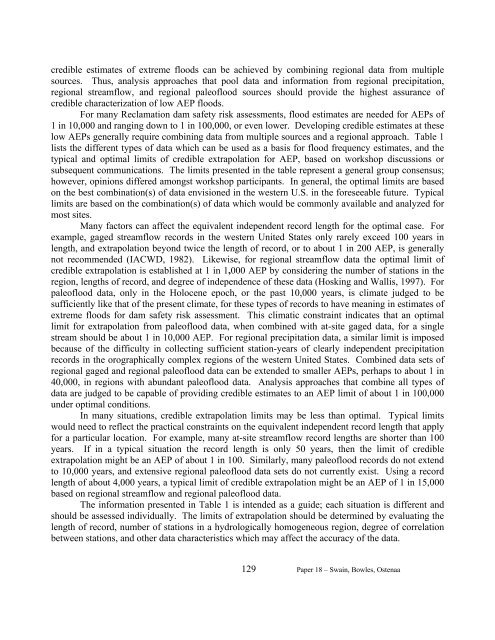Hydrologic Issues for Dams - Association of State Dam Safety Officials
Hydrologic Issues for Dams - Association of State Dam Safety Officials
Hydrologic Issues for Dams - Association of State Dam Safety Officials
You also want an ePaper? Increase the reach of your titles
YUMPU automatically turns print PDFs into web optimized ePapers that Google loves.
credible estimates <strong>of</strong> extreme floods can be achieved by combining regional data from multiplesources. Thus, analysis approaches that pool data and in<strong>for</strong>mation from regional precipitation,regional streamflow, and regional pale<strong>of</strong>lood sources should provide the highest assurance <strong>of</strong>credible characterization <strong>of</strong> low AEP floods.For many Reclamation dam safety risk assessments, flood estimates are needed <strong>for</strong> AEPs <strong>of</strong>1 in 10,000 and ranging down to 1 in 100,000, or even lower. Developing credible estimates at theselow AEPs generally require combining data from multiple sources and a regional approach. Table 1lists the different types <strong>of</strong> data which can be used as a basis <strong>for</strong> flood frequency estimates, and thetypical and optimal limits <strong>of</strong> credible extrapolation <strong>for</strong> AEP, based on workshop discussions orsubsequent communications. The limits presented in the table represent a general group consensus;however, opinions differed amongst workshop participants. In general, the optimal limits are basedon the best combination(s) <strong>of</strong> data envisioned in the western U.S. in the <strong>for</strong>eseeable future. Typicallimits are based on the combination(s) <strong>of</strong> data which would be commonly available and analyzed <strong>for</strong>most sites.Many factors can affect the equivalent independent record length <strong>for</strong> the optimal case. Forexample, gaged streamflow records in the western United <strong>State</strong>s only rarely exceed 100 years inlength, and extrapolation beyond twice the length <strong>of</strong> record, or to about 1 in 200 AEP, is generallynot recommended (IACWD, 1982). Likewise, <strong>for</strong> regional streamflow data the optimal limit <strong>of</strong>credible extrapolation is established at 1 in 1,000 AEP by considering the number <strong>of</strong> stations in theregion, lengths <strong>of</strong> record, and degree <strong>of</strong> independence <strong>of</strong> these data (Hosking and Wallis, 1997). Forpale<strong>of</strong>lood data, only in the Holocene epoch, or the past 10,000 years, is climate judged to besufficiently like that <strong>of</strong> the present climate, <strong>for</strong> these types <strong>of</strong> records to have meaning in estimates <strong>of</strong>extreme floods <strong>for</strong> dam safety risk assessment. This climatic constraint indicates that an optimallimit <strong>for</strong> extrapolation from pale<strong>of</strong>lood data, when combined with at-site gaged data, <strong>for</strong> a singlestream should be about 1 in 10,000 AEP. For regional precipitation data, a similar limit is imposedbecause <strong>of</strong> the difficulty in collecting sufficient station-years <strong>of</strong> clearly independent precipitationrecords in the orographically complex regions <strong>of</strong> the western United <strong>State</strong>s. Combined data sets <strong>of</strong>regional gaged and regional pale<strong>of</strong>lood data can be extended to smaller AEPs, perhaps to about 1 in40,000, in regions with abundant pale<strong>of</strong>lood data. Analysis approaches that combine all types <strong>of</strong>data are judged to be capable <strong>of</strong> providing credible estimates to an AEP limit <strong>of</strong> about 1 in 100,000under optimal conditions.In many situations, credible extrapolation limits may be less than optimal. Typical limitswould need to reflect the practical constraints on the equivalent independent record length that apply<strong>for</strong> a particular location. For example, many at-site streamflow record lengths are shorter than 100years. If in a typical situation the record length is only 50 years, then the limit <strong>of</strong> credibleextrapolation might be an AEP <strong>of</strong> about 1 in 100. Similarly, many pale<strong>of</strong>lood records do not extendto 10,000 years, and extensive regional pale<strong>of</strong>lood data sets do not currently exist. Using a recordlength <strong>of</strong> about 4,000 years, a typical limit <strong>of</strong> credible extrapolation might be an AEP <strong>of</strong> 1 in 15,000based on regional streamflow and regional pale<strong>of</strong>lood data.The in<strong>for</strong>mation presented in Table 1 is intended as a guide; each situation is different andshould be assessed individually. The limits <strong>of</strong> extrapolation should be determined by evaluating thelength <strong>of</strong> record, number <strong>of</strong> stations in a hydrologically homogeneous region, degree <strong>of</strong> correlationbetween stations, and other data characteristics which may affect the accuracy <strong>of</strong> the data.129 Paper 18 – Swain, Bowles, Ostenaa

















